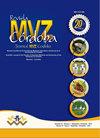添加南瓜对体外瘤胃甲烷产量的影响
IF 0.3
4区 农林科学
Q4 AGRICULTURE, DAIRY & ANIMAL SCIENCE
引用次数: 2
摘要
目标。本研究旨在评价在肉牛日粮中添加瓜叶部分或全部替代苜蓿干草对体外甲烷排放、气体动力学和挥发性脂肪酸产生的影响。材料与方法。在CON(对照)、BG25、BG50、BG75和BG100 5个试验处理中,分别添加0、25、50、75%和100%的BG作为苜蓿干草替代品。结果。随着BG的加入,木质素和有机物含量降低(p0.05)。甲烷产量随添加BG呈线性下降(p0.05)。此外,BG包埋对乙酸和丁酸没有影响(p < 0.05);但各处理间丙酸浓度呈线性增加(p<0.05)。此外,75%的BG减少了31%的体外甲烷产量,而CO2产量没有变化,这表明抑制了内源性甲烷生成。结论。这些结果促进了BG叶作为一种潜在的、环保的肉牛饲料来源。本文章由计算机程序翻译,如有差异,请以英文原文为准。
Reduction in the in vitro ruminal methane production with the inclusion of Cucurbita foetidissima
Objective.This research aimed to evaluate the inclusion of Cucurbita foetidissima (BG) leaves as a partial or total substitution of alfalfa hay (AH) in beef cattle diets on in vitro methane output, gas kinetics and volatile fatty acids production. Materials and Methods.Five experimental treatments were formulated with the inclusion of BG as alfalfa hay (AH) substitute at 0, 25, 50, 75 and 100% in experimental treatments denominated CON (control), BG25, BG50, BG75 and BG100, respectively. Results.Lignin and organic matter decreased with BG inclusion (p<0.05). However, NDF, CT and TPC increased with higher levels of BG (p<0.05). Maximum gas production diminished with BG inclusion (p<0.05); whereas, microbial protein production, specific gas production rate and latency period were not affected (p>0.05). Methane production decreased linearly with BG inclusion (p<0.05). Nevertheless, CO2 production showed no changes with inclusion of graded levels of BG in the experimental treatments (p>0.05). Additionally, acetate and butyrate were not affected by BG inclusion (p>0.05); although, propionate increased linearly among treatments (p<0.05). Furthermore, inclusion of 75% of BG reduced 31% in vitro methane production without changes in CO2 production, suggesting an inhibition of endogenous methanogenesis. Conclusions.These results promote the inclusion of BG leaves as a potential and environmentally friendly forage source for beef cattle feeding.
求助全文
通过发布文献求助,成功后即可免费获取论文全文。
去求助
来源期刊

Revista Mvz Cordoba
农林科学-奶制品与动物科学
CiteScore
0.70
自引率
0.00%
发文量
41
审稿时长
6-12 weeks
期刊介绍:
The Journal MVZ Córdoba is an open access international scientific journal financed and edited by the University of Córdoba (Colombia). The journal publishes quarterly, continuously in PDF, XML, Epub, original articles, literature reviews, brief communications and clinical cases, peer-reviewed (double-blind) in Spanish and English, which are related to the agricultural and veterinary sciences. The journal is directed to natural and legal persons of veterinary medicine, animal husbandry, public health, epidemiology, aquaculture, biology, basic biomedical sciences and biotechnology and constitutes a space for academic and scientific discussion around the work of professionals in Veterinary Medicine and Zootechnics. Four-monthly publication.
"The Journal MVZ Córdoba supports the policies for registration of clinical trials of the World Health Organization (WHO) and the International Committee of Medical Journal Editors (ICMJE), since it recognizes the importance of these initiatives for international registration and dissemination. of information about clinical studies, in open access. As a result, since 2007, the journal MVZ Córdoba only publishes clinical research articles that have received an identification number in one of the Clinical Trial Registries validated by the criteria established by WHO and ICMJE, whose addresses are available in the ICMJE website. The identification number is recorded at the end of the summary. "
 求助内容:
求助内容: 应助结果提醒方式:
应助结果提醒方式:


